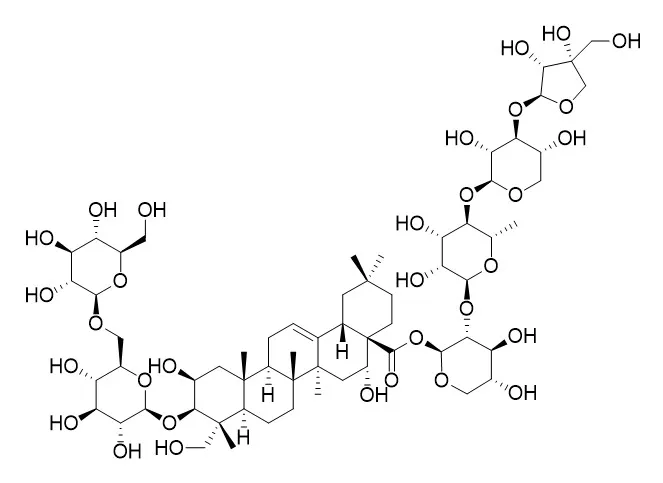| In vitro: |
| Planta Medica, 2005, 71(6):566-568. | | Isolation of a new saponin and cytotoxic effect of saponins from the root of Platycodon grandiflorum on human tumor cell lines.[Reference: WebLink] |
METHODS AND RESULTS:
A novel triterpenoid saponin, deapioplatycoside E (1) was isolated from the root extract of Platycodon grandiflorum, together with the seven known saponins 2 - 8, i. e., platycoside E (2), deapioplatycodin D3 (3), platycodin D3 (4), Polygalacin D2 (5), platycodin D2 (6), deapioplatycodin D (7) and platycodin D (8). The structure of the new saponin 1 was determined on the basis of spectral analysis and chemical evidence.
CONCLUSIONS:
The crude saponin fraction (ED50: ca. 10 - 15 microg/mL) and compounds 6 - 8 (ED50: ca. 4 - 18 microg/mL) exhibited significant inhibition on the proliferation of five kinds of cultured human tumor cell lines, i. e., A549 (non-small cell lung), SK-OV-3 (ovary), SK-MEL-2 (melanoma), XF498 (central nerve system) and HCT-15 (colon), in vitro. | | Journal of the korean society of food science & nutrition, 2016, 45(7):1017-1025. | | Changes in Platycoside Components and Antimicrobial Activities of Bronchus Disease-Inducing Bacteria of Fermented Platycodon grandiflorum Root by Lactic Acid Bacteria.[Reference: WebLink] | This study was performed in order to investigate changes in platycosides, as well as antimicrobial activities of bronchus diseases-inducing bacteria (Corynebacterium diphtheriae, Klebsiella pneumoniae, Staphylococcus aureus, and Streptococcus pyogenes) of Platycodon grandiflorum root (PGR) fermented by lactic acid bacteria (Leuconostoc mesenteroides N12-4, Leuc. mesenteroides N58-5, Lactobacillus plantarum N76-10, L. plantarum N56-12, Lactobacillus brevis N70-9, and L. brevis E3-8).
METHODS AND RESULTS:
Growth of L. plantarum on PGR was most active during lactic acid fermentation using different strains. Total platycoside, platycoside E, platycodin A, Polygalacin D2, polygalacin D, and diapioplatycoside E contents of PGR fermented for 96 h at 37°C by Leuc. mesenteroides and L. plantarum increased, whereas contents of platycodin D and platycodin D3 were reduced. The antimicrobial activity on PGR fermented by L. plantarum N56-12 exhibited strong microbial proliferation for all four kinds of bronchus disease-inducing bacteria and was higher than that of non-fermented PGR extract. MIC of fermented PGR extract by L. plantarum N56-12 on C. diphtheriae, K. pneumoniae, S. aureus, and S. pyogenes were 45, 10, 50, and 25 mg/mL, respectively.
CONCLUSIONS:
Thus, this result shows that the antimicrobial activities of bronchus disease-inducing bacteria and platycoside content of PGR by L. plantarum N56-12 were higher than that of non-fermented PGR extract. |
|






 Cell. 2018 Jan 11;172(1-2):249-261.e12. doi: 10.1016/j.cell.2017.12.019.IF=36.216(2019)
Cell. 2018 Jan 11;172(1-2):249-261.e12. doi: 10.1016/j.cell.2017.12.019.IF=36.216(2019) Cell Metab. 2020 Mar 3;31(3):534-548.e5. doi: 10.1016/j.cmet.2020.01.002.IF=22.415(2019)
Cell Metab. 2020 Mar 3;31(3):534-548.e5. doi: 10.1016/j.cmet.2020.01.002.IF=22.415(2019) Mol Cell. 2017 Nov 16;68(4):673-685.e6. doi: 10.1016/j.molcel.2017.10.022.IF=14.548(2019)
Mol Cell. 2017 Nov 16;68(4):673-685.e6. doi: 10.1016/j.molcel.2017.10.022.IF=14.548(2019)